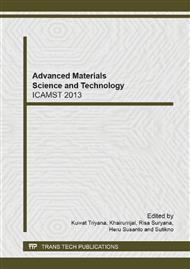[1]
D. Pramanik and A.N. Saxena, VLSI metallization using aluminum and its alloys, Part I, Solid State Technol. 26(1) (1983) 127; Part II, Solid State Technol. 26(3) (1983) 127.
Google Scholar
[2]
S.R. Wilson, C.J. Tracy and J.L. Freemann (eds. ), Handbook of Multilevel Metallization for Integrated Circuits, Noyes Publications, Park Ridge, NJ, (1993).
Google Scholar
[3]
EE. Riley, Plasma etching of aluminum metallizations for ultralarge scale integrated circuit, J. Electrochem. Soc. 140(5) (1993) 1518.
DOI: 10.1149/1.2221589
Google Scholar
[4]
EE. Riley, S.S. Peng and L. Fang, Plasma etching of aluminum for ULSI circuits, Solid State Technol. 36(2) (1993) 47.
Google Scholar
[5]
G.C. Schwartz, Reactive plasma-assisted etching of aluminum and aluminum alloys, in Proc. 5th Syrup. on Plasma Processing (PV85-1), G.S. Mathad et al. (eds. ), (Electrochem. Soc., Pennington, 1985), pp.26-56.
Google Scholar
[6]
H. -J. Tiller, Plasmachemisches Atzen von A1, Wiss. Z. Friedrich-Schiller-Univ. 33 (1-2) (1984) 145.
Google Scholar
[7]
A. Weiss, Plasma etching of aluminum: Review of process and equipment technology, Semicond. Int. 5(11) (1982) 69.
Google Scholar
[8]
R.F. Reichelderfer, Single wafer plasma etching: I. AI and A1/Si alloys, Solid State Technol. 25(4) (1982) 160.
Google Scholar
[9]
D.W. Hess, Plasma etch chemistries of aluminum and aluminum alloy films, Plasma Chem. Plasma Proc. 2(2) (1982)141.
DOI: 10.1007/bf00633130
Google Scholar
[10]
L. Kammerdiner, Aluminum plasma etch considerations for VLSI production, Solid State Technol. 24(10) (1981) 79.
Google Scholar
[11]
D.W. Hess, Plasma etching of aluminum, Solid State Technol. 24(4) (1981) 189.
Google Scholar
[12]
A.W. (Alvin Warren). Czanderna, C.J. (Cedric John) Powell, Theodore E. Madey, Beam Effects, Surface Topography and Depth Profiling in Surface Analysis, Springer, 1998, p.327.
DOI: 10.1007/b119182
Google Scholar
[13]
J. Drelich and J.D. Miller, The Effect of Solid Surface Heterogeneity and Roughness on the Contact Angle/Drop (Bubble) Size Relationship, Journal of Colloid and Interface Science, 164 (1) (1994), p.252–259.
DOI: 10.1006/jcis.1994.1164
Google Scholar


